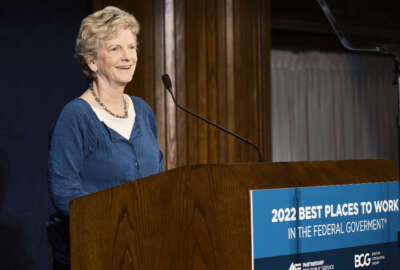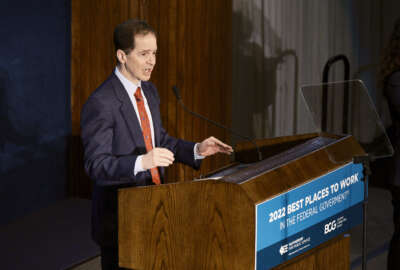
‘Start with encouraging employees to speak up’: Lessons from a steady agency in Best Places to Work
For Best Places to Work, the Energy Department moved from 14th place in the 2021 rankings up to eighth place this year for midsize agencies. The agency’s human...
Leaning into negative feedback from employees is uncomfortable, but necessary.
It’s an idea that Erin Moore, chief human capital officer at the Department of Energy, said contributed to a slow, but steady rise in the agency’s results in the 2022 Best Places to Work in the Federal Government rankings. DoE moved from 14th place in the 2021 rankings, up to eighth place this year for midsize agencies.
“It’s human nature to try and explain away unfavorable results. We do it in our personal lives, we do it in our work lives. But the explanations that we give ourselves don’t change the results,” Moore told Federal News Network.
At the same time the governmentwide score in the Partnership for Public Service’s rankings sank 1.1 points, Energy increased its employee engagement and satisfaction score by 1 point. The department was one of just 19 agencies in the rankings this year that either improved or held steady.
During the Federal Employee Viewpoint Survey (FEVS) season, an annual survey for federal employees that the Office of Personnel Management distributes governmentwide, Energy leaders focus heavily on encouraging employees to participate. Energy’s different department heads hold weekly competitions to see who has the best response rates, keeping employees up-to-date on who’s pulling ahead each week that the survey is open to responses.
“Much of this does start with encouraging employees to speak up and provide feedback on their work environments,” Moore said. “From our daily leaders, starting with the secretary and the deputy, on down to frontline managers and our supervisors, we promote the importance of FEVS and we actively encourage employees to participate in the survey.”
Each year, Energy leaders also encourage employees to set aside time during their workday to take the survey.
“We found that that’s one of the best practices to ensure that people were doing it on their work time and not thinking that they have to use their personal time to give feedback on what they really think about the department,” Moore said.
For Moore, the pay-off is immense. Almost 70% of eligible DoE employees participated in the 2022 FEVS — roughly double the governmentwide response rate.
In the Best Places to Work results, largely based on data from FEVS, Energy’s high level of feedback shines through as well. The department’s engagement and satisfaction score was 73.7 out of 100, about 20 points above its lowest score of 53.8 in 2014. The department also recovered from a slight drop in its score in 2021.
Moore was “thrilled” that the agency was in the top 10 midsize agencies in the rankings, but of course, the work to engage employees never ends.
Now, she and her human capital team are turning their attention to one area in particular: leadership.
“We know an organization’s culture is set by its leadership and that leaders have an outsized impact on employee engagement,” Moore said. “We have to lead by example.”
Typically, immediate supervisors receive higher scores than top agency leadership. For federal employees, there will most likely always be a gap in those perceptions.
But for 2022, the governmentwide gap was much steeper than usual. The Partnership’s overall leadership category, which measures the performance of supervisors, managers and senior leaders, had a score of 67.3 out of 100 for 2022. Supervisors received a score of 79.7, about 25 points higher than senior leaders’ score of 55.3.
But for Energy, the majority of leadership category measurements rose slightly, except for the leadership empowerment category, which fell by 3.8 points.
To try to address that category, DoE senior leadership is encouraging all of the department’s executives to participate in a new leadership development program, called “Let’s Lead.”
“Leadership is a skill in its own right, one that requires constant training — whether one is a new manager, or you’ve been doing it for years,” Moore said. “You still need to focus on it and work on it to improve.”
The leadership development program has a structured curriculum targeting areas such as fostering trust and respect, addressing issues and communicating effectively.
“We’ve done a new suite of on-demand courses that have over 70,000 new learning assets for every employee,” Moore said. “That’s a comprehensive program for [the Senior Executive Service] and senior leadership, as well as through the entire rank.”
The department also has a tool that agency leaders can use to look at specific areas of FEVS. Energy’s new tool lets leaders feed different questions from FEVS into the system. Then they receive specific, identifiable areas of focus in the FEVS results that leaders can look at to target growth in the years to come.
Energy has seen positive pay-off of its employee engagement efforts in other areas. Notably, employees responded 91% positively in the 2022 FEVS for a question on supervisory support of work-life balance. And the FEVS results were 80% positive for employees who say they have the information they need to do their jobs.
But for Moore, managing employees’ workloads is still a concerning area of FEVS. She’s looking to promote healthier approaches to work-life balance by expanding employee wellness offerings.
“We know that there are several key factors that make an employer of choice — connection to the work and mission, having a positive relationship with your peers, investing in your people and workplace flexibilities,” Moore said.
Employee’s feedback isn’t one-size-fits-all, either. Moore’s team also puts together individual reports for each organizational level in the department. For 2022, her team issued more than 600 reports agency-wide.
“We are able to provide really granular data to many of our departments,” Moore said. “Then my team can work with the leadership in those organizations to help them best share their organizational results. We really feel it’s important to be transparent with the data and make sure employees know the results, and that DoE will be acting on the input that they’ve provided us.”
Beyond looking at individual departments within Energy, Moore said she also collaborates with other chief human capital officers governmentwide.
“The broader [human capital] community is always extremely generous in sharing best practices,” she said. “We are always willing to share what we’ve learned, either through a success, or through a misstep that we had of what not to do. It’s really reaching out to others who have done this, learn what they did and see how you can apply that to your own organization.”
Copyright © 2025 Federal News Network. All rights reserved. This website is not intended for users located within the European Economic Area.
Drew Friedman is a workforce, pay and benefits reporter for Federal News Network.
Follow @dfriedmanWFED
Related Stories




